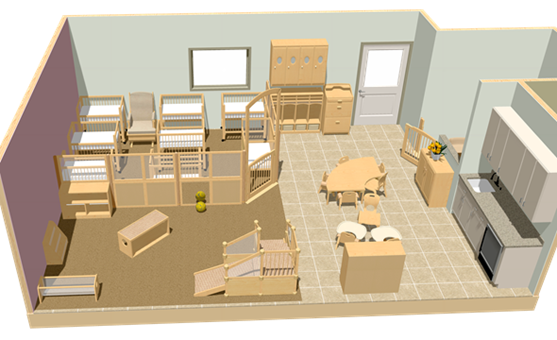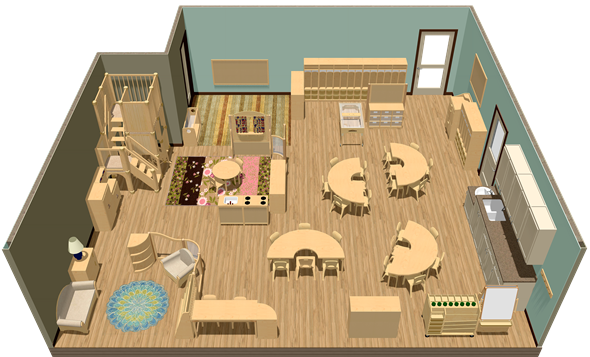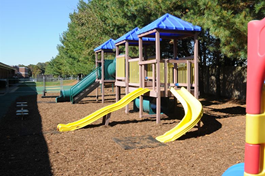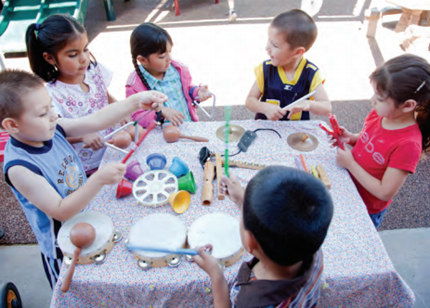5.7: Creating Environments for Infants and Toddlers **
The infant/ toddler framework proposes the following play spaces to consider for an infant/toddler program:
- A cozy area for books and stories
- A small-muscle area
- A sensory perception area
- An active movement area
- A creative expression area
Here is a sample infant/toddler classroom. See Appendix B for an older toddler classroom and for the corresponding blueprints.

Creating Environments for Preschoolers
The preschool framework offers the following list of suggested play spaces when creating a learning environment for children three to five years of age:
- Dramatic play area
- Block area
- Art area
- Book area
- Writing area
- Math area
- Science/Sensory area
- Family display area
- Music/movement
- Meeting area (for conferencing)
And here is a sample preschool classroom. Additional sample classrooms for preschoolers and corresponding blueprints can be found in Appendix B.

In both cases, it is helpful to think of ways that the spaces can be used by two or three children together, one child alone, or an adult and one or two children, as well as larger areas for more exuberant group play. Providing opportunities for small configurations enables the play space to support growing social relationships and meet needs of children who prefer more defined space or space away from others. [1]
Licensing Requirements for Indoor Preschool Classrooms in California
Here are a few of the licensing requirements to keep in mind when planning indoor environments for young children in California:
The program provides for quiet and active play, rest and relaxation, eating, and toileting. (101230)
35 square feet of indoor activity space per child (not including bathrooms, halls, offices, food preparation areas, or storage. (101238)
That each child has individual storage space for clothing, personal belongings, and bedding. (101238)
Storage must be provided for play materials, equipment, and napping equipment. (101238)
Combustibles, cleaning equipment and cleaning agents shall be stored in an area separate from food supplies in a locked cabinet or in a location inaccessible to children. (101238)
Tables and chairs scaled to the size of children must be provided. (101239)
All play equipment and materials used by children must be age-appropriate. (101239)
Drinking water must be available freely to children. (101239)[2]
Ensuring Quality in the Indoor Environment
Tools, such Environment Rating Scales, can be used to help ensure the environment is high quality. Here are some items that describe high quality indoor environments for preschool-aged children according to the Early Childhood Environment Rating Scale (ECERS).
- Space is accessible to children and adults, including those with disabilities
- There is ample space for the people and furnishings
- Adequate storage and seating
- Storage for play materials and personal belongings are accessible to children
- Cozy spaces and other soft furnishings and materials are provided
- At least five of the following centers are provided and accessible to children:
- Art
- Blocks
- Dramatic Play
- Reading
- Nature/Science
- Manipulatives/Fine Motor
- Spaces for active and quiet activities are separated
- There is more than one space for a child to have privacy
- Children’s work makes up a majority of the classroom display
- Diversity is featured throughout the space (people of different races, cultures, ages, abilities, and gender in non-stereotyping roles)
- New materials are provided/rotated at least monthly
- The following materials are provided to children
- Books feature many topics/genres
- Fine motor toys (such as building materials, puzzles, art materials, and manipulatives)
- Art materials (such as drawing materials, paints, play dough, clay, collage materials, and tools)
- Musical instruments and different types of music
- Blocks (such as unit blocks, large hollow blocks, and homemade blocks) and accessories
- Dramatic play equipment and props
- Sand and water play equipment and materials (such as containers, funnels, scoops, and accessories)
- Natural materials (such as collections, living things, books, games, toys, and tools)
- Materials featuring numbers and shapes
- All materials are organized and in good condition
- Materials of differing levels of difficulty are provided[3]
Outdoor Spaces
The areas highlighted in the frameworks should be represented in outdoor play spaces as well. Materials may vary but all areas should be reflected in both the indoor and outdoor environments.
Many outdoor spaces feature play equipment, such as what is shown in the following image, which is a great way to provide for children’s large motor play and exploration.

But materials and experiences that would typically be indoors can easily be taken outside as well.

A variety of additional equipment can be purchased to expand children’s experiences outside, although a large budget is not required to create high quality outdoor spaces for young children.


Programs may choose to provide a playground made of natural materials to immerse children in nature as well.

Licensing Requirements for Indoor Preschool Classrooms in California
Licensing Requirements for Indoor Preschool Classrooms in California
The following are some licensing requirements that programs in California should incorporate in the design and planning for their outdoor space:
There shall be at least 75 square feet per child of outdoor activity space. (101238)
The outdoor space shall permit children to reach the space safely. (101238)
A shaded rest area should be provided. (101238)
The surface of the activity space shall be in a safe condition and free of hazards. (101238)
The areas around and under climbing equipment, swings slides and similar equipment shall be cushioned with material that absorbs falls. (101238)
Equipment and activity areas shall be arranged so that there is no hazard from conflicting activities. (101238)
Sandboxes shall be inspected daily and kept free of foreign materials. (101238)
The playground shall be enclosed by a fence at least four feet high. (101238)
Hazardous equipment such as a fuse box shall be inaccessible. (101238)[4]
Ensuring the Quality of the Outdoor Environment
According to the ECERS, here are some items that describe high quality outdoor spaces for children. See Appendix C for the full checklist:
- There is adequate space for gross motor play
- The space is easily accessible to children
- The space is organized so activities do not interfere with one another
- The following materials are included
- Stationary equipment (such as, swings, slides, climbing equipment)
- Portable equipment (such as, wheeled toys, mats, jump ropes, bean bags, balls)
- Equipment that stimulates
- Balancing
- Climbing
- Ball play
- Steering
- Tumbling
- Jumping
- Throwing
- Pedaling
- Equipment provides skill development at multiple levels
- Enough equipment that children do have to wait long to play
- Equipment is in good repair
- Equipment is appropriate for the age and ability of the children
- Adaptations are made for children with disabilities[5]
- The Integrated Nature of Learning by the California Department of Education is used with permission (pg. 24-29) ↵
- Child Care Center General Licensing Requirements is in the public domain ↵
- MiraCosta College (n.d.). Preschool Environment Checklist. Retrieved from https://www.miracosta.edu/instruction/childdevelopmentcenter/downloads/5.2PreschoolEnvironmentChecklist.pdf ↵
- Child Care Center General Licensing Requirements is in the public domain ↵
- MiraCosta College (n.d.). Preschool Environment Checklist. Retrieved from https://www.miracosta.edu/instruction/childdevelopmentcenter/downloads/5.2PreschoolEnvironmentChecklist.pdf ↵

